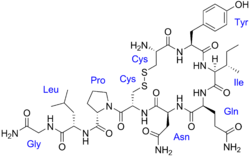Scent A: Passion & Desire. Sex and Lust. Raw and Physical.
Endorphins
What are Endorphins?
First discovered in 1975, endorphins ("endogenous morphine") is one of several morphine-like substances (opioids) discovered within our brains as recently as thirty years ago. Endorphins are polypeptides containing 30 amino acid units. Opioids are considered stress hormones like corticotrophin, cortisol, and catecholamines (adrenaline, noradrenaline), and are manufactured by the body to reduce stress and relieve pain. Usually produced during periods of extreme stress, endorphins naturally block pain signals produced by the nervous system. The human body produces at least 20 different endorphins with possible benefits and uses that researchers are investigating. Beta- endorphin appears to be the endorphin that seems to have the strongest affect on the brain and body during exercise; it is one kind of peptide hormone that is formed mainly by Tyrosine, an amino acid. The molecular structure is very similar to morphine but with different chemical properties.
The blissful feeling one often experiences after making love is due to the body's production of endorphins: in fact, endorphin production can increase 200% from the beginning to the end of sexual activity. Recent studies, beginning with those of Candace Pert, Ph.D. of Johns Hopkins University, have documented the connection between orgasm and endorphins, although ongoing physical contact, and not just sex alone, also helps produce endorphins, along with the hormone oxytocin. Together, they are like natural opiates and help stabilize a relationship between a loving couple by inducing what famed obstetrician Michel Odent, of London's Primal Health
Natural Chemicals linked to Physical Sexual Activity
Testosterone: Testosterone is known as the hormone of sexual desire in both men and women. For men, however, it is the key hormone of desire, triggering feelings of positive energy and well-being.
Oxytocin: The flood of oxytocin at climax acts as a natural tranquilizer, lowering blood pressure, blunting sensitivity to pain and stress, and inducing sleep.
Serotonin: This natural chemical is released right after climax, bringing on a deep feeling of calmness, satisfaction and release from stress. Anti-depressant drugs like Prozac are designed to increase levels of serotonin.
Looking back over these three chemicals I think the most that is linked to the scent of passion, desire sex and lust is probably Testosterone. It is known as the hormone of sexual desire in both men and women. It triggers feelings of positive energy and well being.
Testosterone
Testosterone is a steroid hormone from the androgen group and is found in mammals, reptiles, birds, and other vertebrates. In mammals, testosterone is primarily secreted in the testicles of males and the ovaries of females, although small amounts are also secreted by the adrenal glands. It is the principal sex hormone and an anabolic steroid.
Scent B: Perfect, Sublime Love. An Interior Emotion
Love as Emotion
We call it love. It feels like love. But the most exhilarating of all human emotions is probably nature’s beautiful way of keeping the human species alive and reproducing.
With an irresistible cocktail of chemicals, our brain entices us to fall in love. We believe we’re choosing a partner. But we may merely be the happy victims of nature’s lovely plan.
Psychologists have shown it takes between 90 seconds and 4 minutes to decide if you fancy someone.
Research has shown this has little to do with what is said, rather
55% is through body language
38% is the tone and speed of their voice
Only 7% is through what they say
Oxytocin - The cuddle hormone
Oxytocin is a powerful hormone released by men and women during orgasm.
It probably deepens the feelings of attachment and makes couples feel much closer to one another after they have had sex. The theory goes that the more sex a couple has, the deeper their bond becomes.
Oxytocin also seems to help cement the strong bond between mum and baby and is released during childbirth. It is also responsible for a mum’s breast automatically releasing milk at the mere sight or sound of her young baby.
Diane Witt, assistant professor of psychology from New York has showed that if you block the natural release of oxytocin in sheep and rats, they reject their own young.
Conversely, injecting oxytocin into female rats who’ve never had sex, caused them to fawn over another female’s young, nuzzling the pups and protecting them as if they were their own.
Oxytocin also seems to help cement the strong bond between mum and baby and is released during childbirth. It is also responsible for a mum’s breast automatically releasing milk at the mere sight or sound of her young baby.
Diane Witt, assistant professor of psychology from New York has showed that if you block the natural release of oxytocin in sheep and rats, they reject their own young.
Conversely, injecting oxytocin into female rats who’ve never had sex, caused them to fawn over another female’s young, nuzzling the pups and protecting them as if they were their own.
Oxytocin
Oxytocin (Oxt) is a mammalian neurohypophysial hormone that acts primarily as a neuromodulator in the brain.
Oxytocin plays roles in sexual reproduction, in particular during and after childbirth. It is released in large amounts after distension of the cervix and uterus during labor, facilitating birth, maternal bonding, and, after stimulation of the nipples, breastfeeding. Both childbirth and milk ejection result from positive feedback mechanisms.
Recent studies have begun to investigate oxytocin's role in various behaviors, including orgasm, social recognition, pair bonding,anxiety, and maternal behaviors. For this reason, it is sometimes referred to as the "love hormone". There is some evidence that oxytocin promotes ethnocentric behavior, incorporating the trust and empathy of in-groups with their suspicion and rejection of outsiders.. Furthermore, genetic differences in the oxytocin receptor gene (OXTR) have been associated with maladaptive social traits such as aggressive behaviour.
From this information gathered above, it is clear that the 'Oxytocin' hormone is the one that is linked closest to Love. It is even entitled the 'love hormone'.





Leave your comment